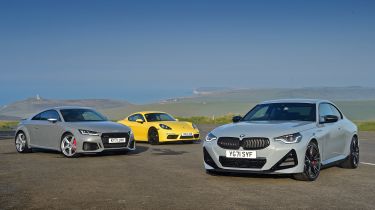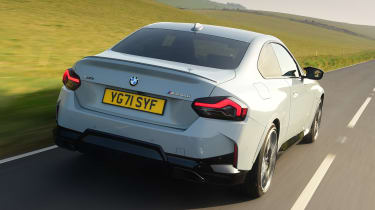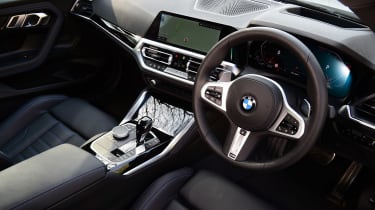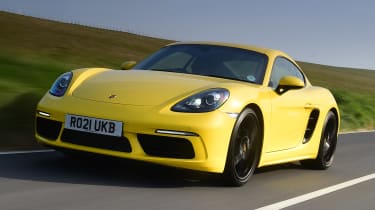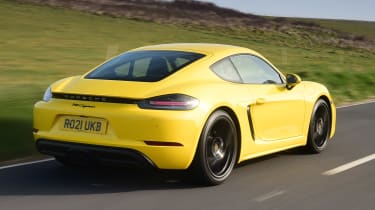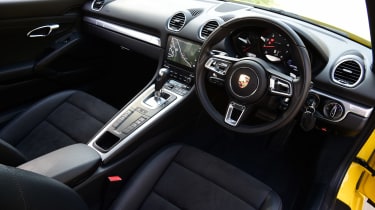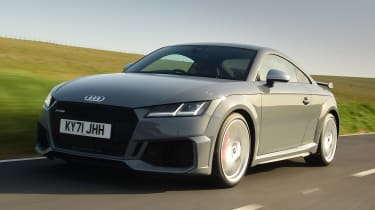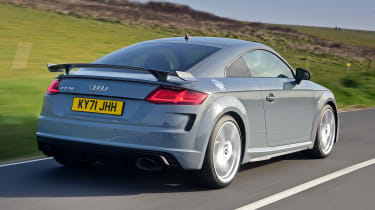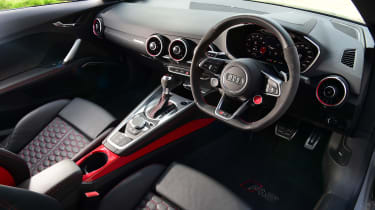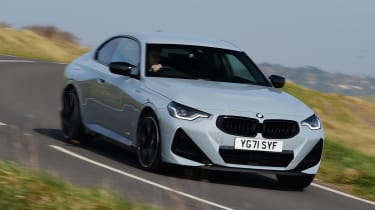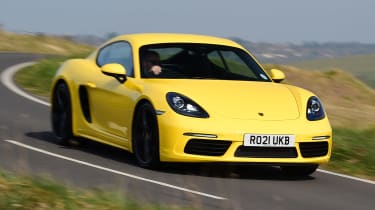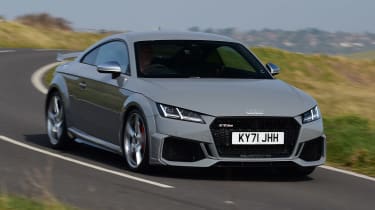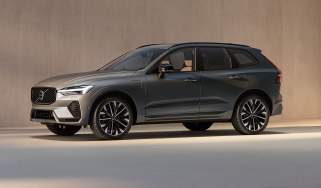BMW M240i Coupe vs Porsche 718 Cayman vs Audi TT RS: 2022 group test review
BMW M240i, Porsche 718 Cayman and Audi TT RS flex their muscle, but which sports coupe wins out?
On the face of it, you could think that creating a sports coupe is easy. Make it fast, make it exciting and make it handsome, and everybody will throw you cash to get behind the wheel, surely?
As it turns out, there’s more to it than that. For a start, there’s the question of where to draw the line between speed and practicality. Then you need to decide which engine to use to get that essential shove. Even which wheels to drive is up for debate. Here, we have a trio of cars that take three wildly different approaches to achieve the same goal. Just consider the engines; these sports cars have four, five and six-cylinder powerplants, with 2.0, 2.5 and 3.0-litre capacities respectively.
The BMW M240i has the largest unit of the three. The newcomer sits at the top of a wider 2 Series range, which has taken a big step forward from its predecessor. Next down the capacity list is the Audi TT RS. It’s the fastest car here – but is that enough against two legendary performance marques?
The third competitor comes in the unmistakable shape of the 718 Cayman. This is the entry point to Porsche’s coupe line-up, but experience has shown us that won’t be reason enough to count it out.
BMW M240i Coupe
| Model: | BMW M240i xDrive Coupe |
| Price: | £45,795 |
| Engine: | 3.0-litre 6cyl turbo, 369bhp |
| 0-62mph: | 4.3 seconds |
| Test economy: | 27.4mpg/6.0mpl |
| CO2: | 200g/km |
| Annual road tax: | £520 |
We were big fans of BMW’s most brutish versions of its previous compact coupe, so with all the changes the manufacturer has made for this newcomer, can it hold on to the same magic? Prices for the M240i start from £45,795; with options, the model here comes to £49,840.
Used - available now

2023 Ford
Fiesta
9,322 milesManualPetrol1.0L
Cash £15,649
2016 Suzuki
Vitara
48,390 milesManualPetrol1.6L
Cash £9,772
2023 Ford
Fiesta
6,514 milesManualPetrol1.0L
Cash £16,968
2022 Toyota
Corolla Touring Sports
21,663 milesAutomaticPetrol2.0L
Cash £20,491Design & engineering
While the name remains the same as that of its predecessor, there are big changes under the skin of the M240i. It now moves on to BMW’s Cluster Architecture (CLAR) platform, which aligns it more closely with its 3 Series and 4 Series stablemates – and is totally different from the front-wheel-drive 2 Series Gran Coupe and Active Tourer models. According to the brand, the move to CLAR brings with it “a clear improvement in agility, steering precision and cornering dynamics”, and increases torsional rigidity by 12 per cent compared with the previous model. It also enables the implementation of improved tech – in terms of both safety and infotainment systems.
In addition, it results in pronounced growth. The new model is 105mm longer than the old car, with 51mm of that distance between the front and rear axles. However, the roofline has dropped by 28mm which, combined with track widths that are up by 63mm at the front and 35mm at the back, gives the newcomer a more powerful stance on the road. Aluminium suspension arms reduce unsprung mass, and the M240i’s state of chassis tune is distinct from that of the rest of the 2 Series Coupe range.
The model also feels much more substantial inside. Its dashboard layout is virtually identical to the 4 Series Coupe’s, although there are unique door inserts that feature a gently glowing panel to complement the rest of the interior’s ambient lighting. Quality is excellent, but the pedals have quite a pronounced offset to the right.
As with the dashboard, the M240i’s engine is also borrowed from its big brother. Its 3.0-litre twin-turbo straight-six sends drive to all four wheels via an eight-speed automatic box. With 369bhp, its total power isn’t far short of the Audi TT RS’s, and its peak torque is 10Nm higher. However, the M240i tips the scales at a portly 1,765kg, which is 315kg more than the Audi and 400kg more than the Porsche.
Driving
Despite that fairly chunky mass to move around, the M240i feels anything but slow. Officially, it’ll crack the 0-62mph sprint in just 4.3 seconds, yet it’s the way it feels so keen to spring forward at any revs and in any gear that sets it apart from the Porsche and runs the Audi so close.
It’s got bags of character, too; the rich six-cylinder soundtrack only adds to the sense of excitement, and it even sounds special if you’re pottering around at low speeds. The auto gearbox changes through ratios cleanly, if not quite as quickly as the Porsche.
Through the corners, the M240i puts its fabled 50:50 weight distribution to brilliant effect. The centre of mass feels centred around the driver’s hips, and it means there’s little inertia when turning into a corner. It might feel more substantial than the other two – especially during quick direction changes – but that by no means makes it seem lazy.
The steering plays a part, too; the rack is fairly quick, and is well matched to the roll response of the body. We’d like it to give a little more detail through the rim when the tyres are reaching their limits of grip, though. Despite the fact that the engine’s torque is distributed to all four wheels, the M240i still offers a distinctly rear-driven balance in its overall behaviour – unlike the Audi, which feels a bit nose-heavy in comparison.
The BMW achieves this while still managing to deliver a compliant ride. There’s little to choose between the different modes on the adaptive dampers, so whichever you go for, the BMW feels relaxing yet controlled. It adds up to a car that, of this trio, would make for the greatest continent crosser.
Practicality
Although things such as legroom and boot space won’t be towards the top of most sports car buyers’ priorities, in this company the M240i is the only one to have if you ever intend to carry more than one passenger. The back seats are a bit of a squeeze for tall adults, but they are absolutely fine for most people on short journeys, and much better than the near-useless Audi seats.
The 390-litre boot is the largest here, although the other two cars have hatchback openings that make access a little easier than through the BMW’s saloon-like bootlid. What matters for active people, however, is that if you fold down the back seats, there’s enough room to slot a road bike into the space.
Ownership
Quite unusually for a brand-new car, and certainly for a BMW, the 2 Series range failed to achieve a maximum five-star rating when it was tested by Euro NCAP.
However, its four stars were achieved against the latest 2022 standards – the most stringent that have yet been implemented. Regardless, in could be the safest in this company; the TT scored only four stars to the standards of 2015, while the Cayman hasn’t been tested.
Running costs
If there is one downside to the BMW having the biggest body, the biggest engine and the most weight in this test, it’s efficiency. We averaged 27.4mpg in our time with the car, although that’s not bad considering the performance on offer. However, the Porsche was nearly 6mpg more frugal.
With today’s high petrol prices, that translates to a fuel bill of £5,429 over 20,000 miles for the BMW, which is £949 more than the Cayman over the same distance. The Audi just pipped the BMW to 28.1mpg.
Testers’ notes: “The new kidney grilles are possibly the best-looking of any recent BMW’s. They also get active flaps, which close at speed to improve economy.”
Porsche 718 Cayman
| Model: | Porsche 718 Cayman PDK |
| Price: | £47,230 |
| Engine: | 2.0-litre 4cyl turbo, 296bhp |
| 0-62mph: | 4.9 seconds |
| Test economy: | 33.2mpg/7.3mpl |
| CO2: | 201g/km |
| Annual road tax: | £520 |
Prices for the Porsche 718 Cayman start from £47,230 when fitted with the PDK dual-clutch automatic gearbox, but a range of extras including adaptive dampers (£1,010), 20-inch wheels (£1,734) and torque vectoring with a locking differential (£926) lift the total cost of our test car to £54,982.
Design & engineering
The introduction of the latest version of the Cayman reintroduced the 718 moniker from Porsche’s past. It looks back to the various 718 models that achieved so much success for the brand in the fifties and sixties, all of which were powered by flat-four-cylinder engines.
And that is relevant because – upon its release – the 718 became the first Porsche since the mid-nineties to sport a four-cylinder arrangement. The 2.0-litre unit keeps the centre of gravity low, and while its 296bhp and 380Nm are some way short of the figures of its rivals here, it’s offset slightly by the fact that the 718 is also the lightest contender.
As you’d expect from its manufacturer, the 718 Cayman perfectly fits the typical sports car template. While its two competitors locate their engine ahead of the occupants in the traditional manner, the Porsche is mid-engined, which places the heaviest part of the car right between the front and rear axles.
Suspension is by MacPherson struts all round, while our car is fitted with the optional PASM system, which features adaptive dampers and lowers the chassis by 10mm compared with the standard passive set-up. It’s also the only car here that sends its drive exclusively to the back wheels.
Slide into the Cayman’s low seats, and the cabin instantly feels special. It’s more than just the big Porsche logo on the steering-wheel boss that gives that impression, too. The driving position is perfect; there’s none of the ‘twisting’ you experience when you sit inside the M240i, and the controls have plenty of adjustment. The quality seems flawless: every last switch operates with a satisfying click. All of the major controls feel lovely to hold, too.
Driving
On first impressions, the Porsche might not generate the level of excitement that you might hope for, and it’s because of that engine. The four-cylinder unit chunters away at idle, and it sounds rough through much of its rev range. In the company of the two fantastic powerplants here, it’s found wanting when it comes to excitement. It’s not particularly audible, either, because the 718’s quite pronounced road noise tends to drown it out. It’s effective, though; a linear powerband gives the driver plenty of incentive to venture right towards the red line, even if the noise the engine makes doesn’t.
But delve deeper into the Cayman’s traits, and it starts to reveal why this Porsche is such a revered sports car. The steering feels better judged in its sensitivity compared with the BMW’s, and it has a much more natural weighing than the Audi’s set-up. It is more precise than either rival.
Then there’s the seven-speed PDK transmission, which is simply sublime. It makes the (still-excellent) BMW unit feel laggy, and the Audi’s unit seem rather dim witted. Surprisingly, the gulf in the quality of the gearboxes is at its most pronounced around town; where the Audi lunges and slips its clutches when moving off (forwards or backwards), the Porsche just goes – and does so immediately and with no fuss whatsoever.
The chassis itself is superb. While you’d expect it to feel more agile than the BMW’s, thanks to a 400kg weight advantage, the fun lies much deeper than that. More than either rival here it reacts to the finest inputs, encouraging you to alter the balance of the car from one corner to the next with deliberate adjustments with the throttle, brakes and steering. Where the other two models mask slightly clumsy driving, the Cayman rewards precision.
Practicality
While it’s a compact machine, the 718 is more practical than you might first expect. That mid-engined layout allows not only a modest 184-litre boot just behind the engine, but also a further 150 litres at the front.. The latter is deep enough for a small suitcase, while the one in the back is good enough for soft bags.
Inside, two cup-holders are hidden behind the trim panel that runs across the passenger’s side of the dashboard, while small fold-out door pockets can hold a few items. Isofix mounting points can be added as a £126 option to the front passenger seat. The BMW gets two Isofix points in the back, as does the Audi – although it’s hard to imagine what child seats would actually fit in there.
Ownership
In our most recent Driver Power owner-satisfaction survey Porsche excelled, taking first place not only in the manufacturer category, but also for the service provided by its dealer network. In contrast, BMW as a brand finished 21st out of the 29 makers covered in the survey, and its dealer network took a middling 11th place out of 21. Audi performed worse still, taking 23rd and 18th in the respective rankings.
Running costs
Not only is the Porsche the most fuel-efficient car here, but the draw of that logo will also save you money in the long run. After three years of ownership, the 718 is predicted to hold on to 62.4 per cent of its value, losing £17,754 of that circa-£47,000 asking price.
The BMW’s residuals are expected to be quite strong, at 57.3 per cent, which translates to a £19,545 loss over the same period. The Audi is expected to depreciate most of all, holding on to only 49 per cent of its value. As the most expensive car in the first place, that means there’s quite a significant drop; it’s expected to lose £29,225 across the three years.
Testers’ notes: “While 296bhp might seem low in this company, the base 718 Cayman has a virtually identical power output to a 911 Carrera from the late nineties.”
Audi TT RS
| Model: | Audi TT RS 2.5 TFSI quattro |
| Price: | £57,315 |
| Engine: | 2.5-litre 5cyl turbo, 395bhp |
| 0-62mph: | 3.7 seconds |
| Test economy: | 28.1mpg/6.2mpl |
| CO2: | 202g/km |
| Annual road tax: | £520 |
The TT RS is the most expensive car of these three, but also the most powerful. Prices start from £57,315 for the model we have here, although with extras such as the Comfort and Sound Pack (£1,195), red RS Styling Pack (£1,125) and RS sports exhaust system (£995), the total climbs to £61,150.
Design & engineering
Audi has a historical relationship with both five-cylinder performance engines and four-wheel drive that dates back to the original Quattro from 1980. As with that car, the TT RS is a highly tuned coupe that promises giant-killing pace. It also shares the Quattro’s powertrain philosophy; up front, there’s a 2.5-litre five-pot, which sends its power to all four wheels.
But while the Porsche sits on a dedicated performance-car structure, and the BMW gets a platform adapted from significantly larger and more expensive models, the TT’s origins are a little more mainstream. Beneath the skin, it uses the MQB platform that has been adapted from a range of the Volkswagen Group’s family hatchbacks and crossovers. The transverse engine arrangement ahead of the driver is a layout most suited to efficient packaging rather than a performance car. The suspension is laid out with MacPherson struts at the front complemented by a multi-link set-up at the rear, while the progressive steering system is tuned uniquely for the TT RS.
The third-generation TT might have been around for the best part of eight years now, but its interior design is still among the very best of any new car on sale today. It’s not only the clean, minimalistic theme that impresses, but also the clever details that have been employed to achieve this. The three central air vents, for example, house the heating and fan-speed controls in their centres. The single units on each side of the dashboard adjust the seat heaters.
There’s no touchscreen infotainment system; instead, everything is controlled through the Virtual Cockpit digital driver’s display. The quality feels a match for either of its rivals here, too.
Driving
There’s one thing that dominates the TT’s driving experience: that engine. It sounds wonderful: a warm, full-bodied warble that has more than a few traits of a laid-back R8 V10 to it. Whether you’re making full use of the rev range or simply burbling around below 2,000rpm, it has bags of character that the Porsche’s flat-four simply can’t match, and even the BMW’s straight-six struggles to offer. It’s made even more vocal here by the optional RS sports exhaust, which gives a little more tone out of the back without being too obnoxious.
It’s fast, too. The combination of the most powerful engine here, four-wheel drive and a kerbweight that splits its two rivals, means that the TT takes a mere 3.7 seconds to cover the 0-62mph sprint – 0.6 seconds quicker than the BMW and a full 1.2 seconds faster than the Cayman.
That power can be easily transmitted to the road in the dry without breaking traction. Combined with huge lateral grip, the TT RS delivers devastating cross-country pace. Despite the speed, however, compared with the Porsche it all feels rather numb. Sure, it’s harder to unstick those front tyres in this case, but the limits in the Cayman are transmitted in fine detail through your fingertips, allowing you to really play with the car at its limits. At speed the Audi’s ride is bouncier than that of either competitor, which means it gets thrown off course by mid-corner bumps much more easily. Once you trust that the grip is there you can pretty much ignore this, but it’s not as reassuring initially.
More drivers could drive the Audi more quickly than either rival, more of the time – but those in the Porsche and the BMW will be having more fun.
Practicality
While Audi might claim that the TT is a 2+2, in reality the back seats are utterly useless for actual humans. If the front occupants are above average height, their seat backs will nearly touch the squabs behind, leaving no legroom whatsoever. In reality, it’s best to treat the TT as a spacious two-door hatch; those back seats fold completely flat, growing an already-reasonable 305-litre load space into a very spacious 712 litres.
The boot opening is large, and the boot is a neat square shape, making the generous room available practical and versatile. Cubbies are at a premium, but there’s enough room for two people – even if a cup-holder might prove handy. Storage is roughly on par with the 718’s, but the BMW is more practical.
The big rear window contributes to decent all-round visibility, which means the TT isn’t at all intimidating to drive. The view out the back of the Porsche isn’t quite as clear, but its relatively low nose means makes it a very easy car to place – whether parking or driving enthusiastically.
Ownership
All three of these cars offer very similar warranties; the only real difference is that Porsche’s three-year cover runs for an unlimited mileage, whereas the BMW and the Audi provide three-year/60,000-mile assurance. A three-year breakdown package is standard on the 718 Cayman and the TT RS, while the BMW’s recovery deal runs for only two years.
Running costs
These models don’t make the most sense financially for company car drivers – but few performance machines do. All three sit in the highest 37 per cent Benefit in Kind band, which means their overall costs are separated only by their P11D values. Every year, a higher-rate taxpayer will be obliged to pay £6,637 in deductions for the BMW, £7,184 for the Porsche, and £8,577 for the Audi.
Testers’ notes: “Our test car gets a slightly garish Red RS styling pack inside. We’d save £1,125 and swap this car’s cheap-looking 19in wheels for optional 20in ones.”
Verdict
First place: BMW M240i Coupe
With the new M240i, BMW has produced a brilliant mini-GT car. It’s sharp enough in the bends to thrill, but comfortable enough on long journeys, too. It’s the most spacious and practical car here, its tech is also the best, and it has plenty of equipment. The Porsche might ultimately be a better driver’s car, and the BMW is a little on the thirsty side, but as a complete all-rounder, it is very hard to beat.
Second place: Porsche 718 Cayman
If you’re aiming for the purest, most engaging driving experience, then look no further than the 718 Cayman. Its chassis remains utterly brilliant, and the steering, brakes and gearbox are all fantastic. Strong residuals along with decent economy even make it fairly cheap to run, too. With a more characterful engine it could pip the BMW to victory – but as things stand, it takes a close second place.
Third place: Audi TT RS
It’s very hard to go wrong with any of this trio, but one car must bring up the rear, and this time it’s the TT RS. For many buyers, the wonderful five-cylinder engine alone will be reason enough to head straight to the nearest Audi dealer, and the cabin still feels truly special. However, both the Porsche and the BMW are superior driver’s cars, and the TT’s residual values are by far the worst here.
Other options for similar money...
New: Audi RS 3 Saloon
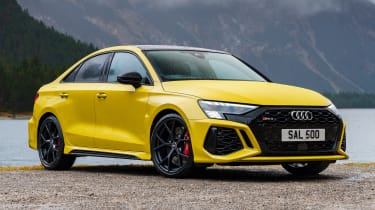
- Price: £56,230
- Engine: 2.5-litre 5cyl, 395bhp
While the TT RS isn’t the most practical car here, you can still get that five-cylinder thrill with a little more space. The RS 3 has the same power and similar dynamics, but with the benefit of a big boot and easy rear access.
Used: Mercedes-AMG C 63 Coupe
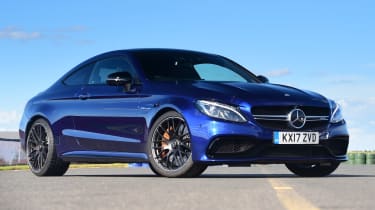
- Price: £48,000 (est)
- Engine: 4.0-litre V8, 469bhp
We have four, five and six-cylinder engines in this group, but dip into the used market and you could buy a V8 instead. The C63’s 4.0-litre engine delivers massive performance and a NASCAR soundtrack.
Figures
| BMW M240i xDrive Coupe | Porsche 718 Cayman PDK | Audi TT RS 2.5 TFSI quattro | |
| On the road price/total as tested | £45,795/£49,840 | £47,230/£54,982 | £57,315/£61,150 |
| Residual value (after 3yrs/36,000) | £26,250/57.3% | £29,476/62.4% | £28,090/49.0% |
| Depreciation | £19,545 | £17,754 | £29,225 |
| Annual tax liability std/higher rate | £3,319/£6,637 | £3,592/£7,184 | £4,289/£8,577 |
| Annual fuel cost (12k/20k miles) | £3,257/£5,429 | £2,688/£4,480 | £3,176/£5,293 |
| Insurance group/quote/VED | 37/£621/£520 | 42/£866/£520 | 43/£1,147/£520 |
| Cost of 1st/2nd/3rd service | £900 (3 years) | £847 (2 years) | £477 (3 years) |
| Length/wheelbase | 4,548/2,741mm | 4,379/2,475mm | 4,201/2,505mm |
| Height/width | 1,404/1,838mm | 1,295/1,994mm | 1,343/1,832mm |
| Engine | 6cyl in-line/2,998cc | 4cyl flat-four/1,988cc | 5cyl in-line/2,480cc |
| Peak power/revs | 369/5,500 bhp/rpm | 296/6,500 bhp/rpm | 395/5,850 bhp/rpm |
| Peak torque/revs | 500/1,900 Nm/rpm | 380/2,150 Nm/rpm | 480/1,950 Nm/rpm |
| Transmission | 8-speed auto/AWD | 7-speed auto/RWD | 7-speed auto/AWD |
| Fuel tank capacity/spare wheel | 52 litres/repair kit | 54 litres/repair kit | 55 litres/repair kit |
| Boot capacity | 390 litres | 334 litres | 305 litres |
| Kerbweight | 1,765kg | 1,365kg | 1,450kg |
| Turning circle | 11.6 metres | 11 metres | 11 metres |
| Basic warranty (miles)/recovery | 3 yrs (60,000)/2 yrs | 3 yrs (unlimited)/3 yrs | 3 yrs (60,000)/3 yrs |
| Driver Power manufacturer/dealer pos. | 21st/11th | 1st/1st | 23rd/18th |
| NCAP: Adult/child/ped./assist/stars | 82/81/67/64/4 (2022) | N/A | 81/68/82/64/4 (2015) |
| 0-62mph/top speed | 4.3 secs/155mph | 4.9 secs/170mph | 3.7 secs/155mph |
| Auto Express econ. (mpg/mpl)/range | 27.4/6.0/313 miles | 33.2/7.3/394 miles | 28.1/6.2/340 miles |
| WLTP combined | 32.1mpg | 31.7mpg | 31.7mpg |
| WLTP combined | 7.1mpl | 7.0mpl | 7.0mpl |
| Actual/claimed CO2/tax bracket | 238/200g/km/37% | 197/201g/km/37% | 232/202g/km/37% |
| Airbags/Isofix | Yes/yes | Yes/£126 | Yes/yes |
| Parking sensors/camera | Yes/yes | £464 (f&r)†/£464† | F&r/£1,195^ |
| Auto box/lane-keep/blind spot/AEB | Yes/yes/£1,000*/yes | Yes/no/£413/no | Yes/no/£595/yes |
| Clim/cruise ctrl/leather/heated seats | Yes/yes/yes/yes | Yes/£228/part/yes | Yes/yes/yes/yes |
| Metallic paint/LED lights | £595/yes | £632/£1,397 | £575/yes |
| Keyless entry & go/powered tailgate | Yes/£500** | No/no | £1,195**/no |
| Sat-nav/digital dashboard | Yes/yes | Yes/no | Yes/yes |
| DAB/connected services | Yes/yes | Yes/yes | Yes/yes |
| Wireless charging | £1,250*** | No | No |
| Apple CarPlay/Android Auto | Yes/yes | Yes/no | Yes/yes |
